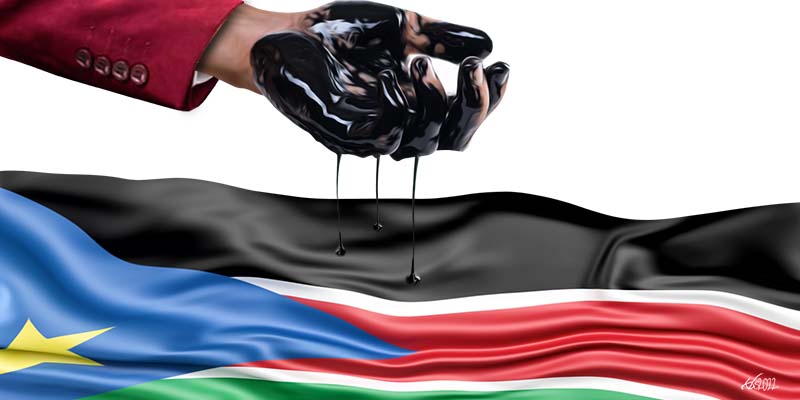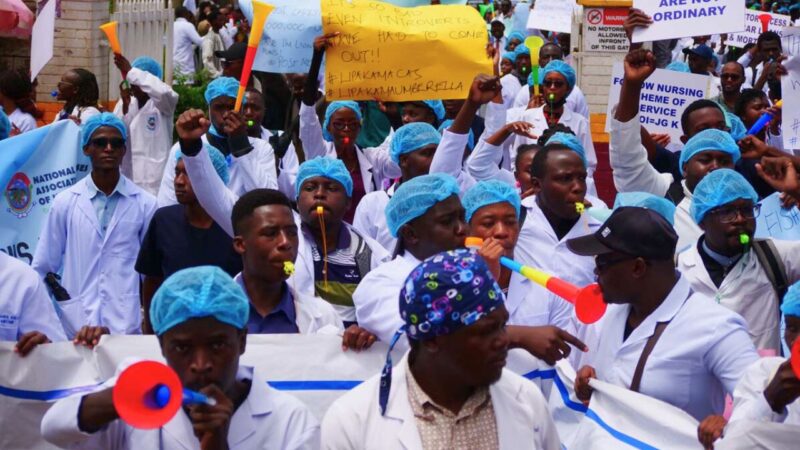South Sudan is caught between a rock and a hard place, heavily dependent on the revenues generated by a resource whose extraction is having a negative impact on the country.
China National Petroleum Corporation (CNPC) operates the Dar Petroleum Operating Company (DPOC) and Greater Petroleum Operating Company (GPOC) consortia that produce all of the country’s oil. CNPC started operating in Sudan in 1996, long before South Sudan became an independent state in 2011, without putting in place proper waste management systems and undertaking environmental audits.
While oil production generates over 90 per cent of the government’s budget, the issue of waste management and accountability has been a continuing challenge. Major environmental damage has been reported in the oil fields, jeopardising the lives of those who live in the oil producing states.
“They don’t care about waste management and environmental protection. They want it cheaper, and the agreements are opaque so I don’t know what they signed, in terms of service delivery and environmental care,” said an analyst who spoke on condition of anonymity.
The source also claimed that DPOC and GPOC are “sabotaging” the regulations developed by the Ministry of Petroleum to avoid their corporate social responsibilities towards the communities and the country. “They [DPOC and GPOC] don’t want the implementation of these policies and recently rejected a comprehensive environmental audit saying they are Western ideas, American ideas.”
In the 90s, aware of the impact that oil extraction would have on local communities, the Sudanese government took the draconian measure of ordering the Sudanese Army to evict the civilian population to make way for exploration and production.
“When South Sudan gained independence it was a new responsibility. The whole point of fighting was to do things differently from the old Sudan. The first thing would have been to change things, but the country couldn’t stop oil production. It was young and needed money to continue running its business, to provide basic services and continue with developmental projects,” said Dr Bior Kwer Bior, founding Executive Director for Nile Initiative for Health and Environment, a member of South Sudan’s Civil Society Coalition on Natural Resources.
Today, the decision to continue with oil production has come to haunt the country in terms of the impact on the environment and on the health of local populations.
“Whenever there’s oil extraction obviously there will be impact on the environment. Normally there are safeguards that are put in place to protect the environment. There should be a plan for protecting the environment, an accurate environmental management system, baseline assessment before you start production, and good ways of waste management,” noted Dr Kwer.
According to article 28 of the South Sudan Petroleum Act, contractors must submit an application to the Ministry of Petroleum for a permit to undertake exploratory drilling. The application must include an environmental and social impact assessment. Regarding transportation, treatment and storage, the Act requires that “detailed information on all relevant issues [. . .] including economic, technical, operational, safety related, commercial, local content, land use and environmental aspects of the project” be provided. The Act further clarifies that “The Ministry shall grant a license on the basis of an evaluation of the application, including the environmental and social impact assessment, and the technical competence, experience, history of compliance and ethical conduct and financial capacity of the applicant and the contractor, as well as safety related aspects.”
However, since its enactment in 2012, the provisions of the Act have not been fully implemented and the country continues to engage with the oil companies without proper environmental and social impact assessments having been undertaken.
Environmental impact
A report released by the Nile Initiative for Health and Environment, recorded that over 218 children were born with deformities as a result of oil pollution in the oil-producing states of Unity and Upper Nile.
The organization says it collected the data from the birth registries of the health facilities in Pariang, Unity State, and from media reports of cases in Upper Nile State. Its tally may undercount the true figure because of the absence of health facilities and road networks in the areas where oil fields are located.
Local populations lack awareness of the dangers of the chemicals and waste materials dumped on their doorsteps, which contaminate the water in the wells and ponds that are used by the communities.
“The topography of Pariang in Unity State is a low land. The water from the crude oil, the waste water, is dumped in local ponds, flows all the way to local streams and this is what is causing diseases,” Dr Kwer said. “As a consequence of oil production, waste is hazardously dumped in the areas, and the containers that used to contain the chemicals are in the hands of the communities being used for drinking water,” he continued.
The water discharged with minimal treatment contains toxins such as hydrocarbons that have had a negative impact on communities in the oil producing regions of Upper Nile State, Unity State, and the Ruweng Administrative Area, which by itself produces over 80 per cent of South Sudanese oil. “The impact is huge and negative, towards the communities, and the land, animals and the air. The processes were not satisfactory to us. First of all, the level of oil spills, in which pipe breaks spill crude oil into the soil [and] the containers of chemical materials which find their way to communities and are being used for domestic activities,” Charles Judo, Chairperson of the Civil Society Coalition on Natural Resources (CSCNR), said in an interview.
Judo observed that although oil production in South Sudan started on the wrong footing, “The government has now agreed to conduct an environmental audit, not only to assess the environment but the social impact of the oil activities. And as a member of the civil society I want to see in the future that all the processes are open and transparent to the public.”
Diplomatic impact
At its meeting in May 2021, the United Nations Security Council (UNSC), renewed for another year the arms embargo, travel ban and assets freeze imposed on South Sudan in 2018. The UNSC also extended for a further 13 months the mandate of the panel of experts tasked with overseeing those measures. The arms embargo prohibits the supply, sale or transfer of weapons, as well as the provision of technical assistance, training and other military assistance to the territory of South Sudan.
Having previously abstained, this time the Chinese government voted for the arms embargo. Economic analysts said that China’s vote was in retaliation against the decision taken by the government of South Sudan to put in place restrictive measures to improve accountability and transparency in the oil sector, in particular the undertaking of an environmental audit and the implementation of the human resource policies developed by the South Sudan Ministry of Petroleum.
The Chinese government had previously abstained but for the first time voted for the arms embargo.
“The Chinese companies recently have seen some line ministries as a threat, and there have been debates with the Ministry of Petroleum, saying they are not happy with the policies the government is trying to impose on the oil companies and that they should be treated exceptionally because they were supporting South Sudan even during the dark days,” said a source who requested anonymity due to the sensitivity of the matter. “They said the environmental audit is expensive. They want samples only taken in one area while others should be skipped.” It is deeply concerning that the Chinese want to dictate what the country should do with its resources.
Contribution by the civil society
The role of civil society is to amplify advocacy efforts and share information to ensure that accountability and transparency are priorities. “Issues to do with monitoring and evaluation of whatever is related to oil, starting from the signing of the contracts, starting [upstream] to downstream. Whatever agreements are about to be reached, civil society ensures there’s transparency,” Judo said.
Some of the concerns raised by citizens include lack of access to timely and reliable information. “The civil society should be empowered to create awareness about agreements reached by the government and other stakeholders, from exploration, production and selling. The role is to ensure the process is flexible and known to all the South Sudanese citizens,” Judo added.
It is deeply concerning that the Chinese want to dictate what the country should do with its resources.
The National Audit Chamber of South Sudan recently issued a report indicating that the 2 per cent share of net petroleum revenues have not been transferred to the oil producing states to finance service delivery and development projects as foreseen in the Petroleum Revenue Management Act 2013 and the Transitional Constitution 2011. The central government has instead reallocated the funds for other use.
“As civil society we are aware and concerned about all these issues. So far, we have been hearing about the processes of signing the agreements but we have never been involved, not only at the signing but also starting from the initial processes and negotiations. There was no transparency and we never had access to contracts to see and compare with other companies. We have never seen the contracts, but from the output, we are not happy about the agreements with the Chinese companies,” said Judo.
Community awareness
Outbreaks of unknown diseases, stillbirths, deformities in new-borns, miscarriages and infertility have been recorded among populations living in oil producing regions yet there is little awareness within these communities of the dangers they face.
The oil companies support development projects such as schools and hospitals but this is part of their corporate social responsibility and not enough. Communities in Pariang County in Unity State and in Paloich in Upper Nile State have held several demonstrations, accusing the oil companies of making empty promises. In August 2020, there was a demonstration over the lack of employment opportunities for local people that had been promised in the Memorandum of Understanding between the government and the oil companies. “They don’t keep their promises but only concede and don’t deliver. Communities need services to be provided to them and this remains key,” said a concerned citizen.
Resource curse
The reconstituted government of National Unity is tasked with the responsibility of reforming the sector and eventually joining the Extractive Industry and Transparency Initiative (EITI) to help the country control and manage well the revenues generated from its natural resources. In so doing, the needs of the communities living in and around the oil producing areas must be prioritised to ensure a do-no-harm approach. In particular, it is crucial that the issue of waste management is addressed as a matter of urgency. The government must also ensure that environmental audits are undertaken before production begins in new oil fields to avoid further environmental degradation.
Outbreaks of unknown diseases, stillbirths, deformities in new-borns, miscarriages and infertility have been recorded among populations living in oil producing regions.
There is also a need to establish accountability mechanisms to ensure that resources are used properly and that the communities in the oil producing regions receive their share of the oil revenues as stipulated in the law.
Further, the government and civil society organizations must educate the communities concerned about the benefits and the challenges that come with oil production activities in their regions, including how relocating to other regions can help them escape the health ordeals that they are currently facing.
It will not be easy to bring order to the sector, especially after more than three decades during which the oil companies explored and produced crude oil without proper government oversight. However, environmental degradation and human suffering must be put to an end as they negate the whole idea of producing oil to fuel development and render the resource a curse rather than a blessing for South Sudan.








